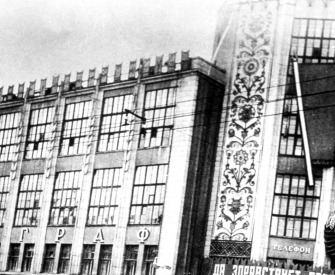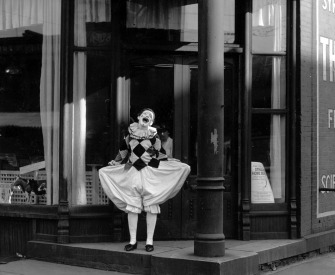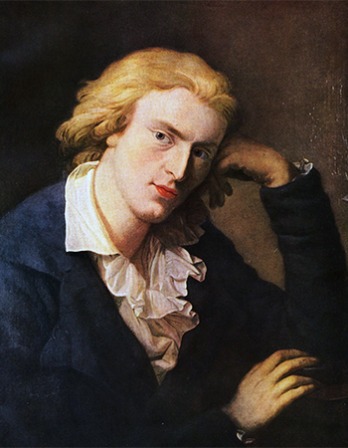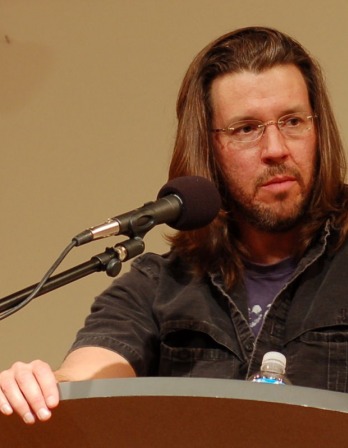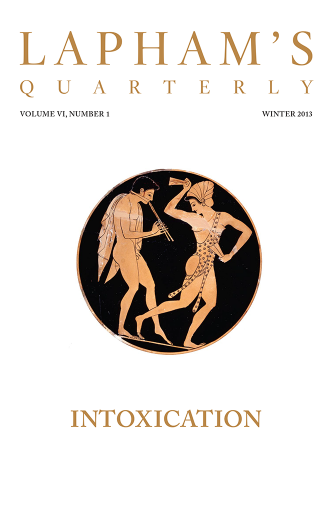Men willingly believe what they wish.
—Julius Caesar, 50 BCStage Light
The life of artist and scenographer Philippe Jacques de Loutherbourg, and the role of the occult in the history of special effects.
By Andrew McConnell Stott

An Audience Watching a Play at Drury Lane Theatre, by Thomas Rowlandson, c. 1785. Yale Center for British Art.
On the evening of October 9, 1773, the Drury Lane theater in the West End of London staged a farce called Miss in Her Teens, a “medley of lovers” already performed more than a hundred times, and a revival of a Alfred, a masque based on the life of the Saxon king Alfred the Great, first produced in 1741 but “not acted these sixteen years.” The bill was hardly unmissable, but when the doors opened that afternoon, a crowd rushed into the pit in a steeplechase of knees and elbows and shouts of watch your pockets!, happy to sit jammed on backless benches for two and a half hours before the show began.
Without even room enough to turn the pages of a book, they entertained themselves however they could, watching the orchestra tune, or in the case of James Boswell, Samuel Johnson’s biographer, “lowing like a cow.” Outside, carriages lined up, depositing ladies and gentlemen whose servants were saving their seats, their silks and jewels attracting a circling horde from the slum behind the theater—fruit sellers and salep men, Irish prostitutes, and “freshwater sailors,” beggars who had never been near a naval battle in their lives but used sham wounds to solicit alms.
At six o’clock the bell sounded and the cast of Alfred took the stage. The piece was a musical burletta set in the year 896, when King Alfred defeated the Danes at sea in a battle popularly believed to mark the birth of the British navy. Its mixture of patriotic songs, interspersed with cod-Shakespearean speeches and a mud-hut romance between a shepherd and his love, was deemed “heavy and dragging” by the Morning Chronicle, and little improved in the sixteen years it had been off the stage.
Yet the production turned a corner in the final scene, in which Alfred encounters a hermit, who reveals to him a vision of military might, set to a now familiar tune:
When Britain first, at heaven’s command,
Arose from out the azure main;
This was the charter of the land,
And guardian angels sang this strain:
“Rule, Britannia, rule the waves:
Britons never will be slaves.”
“As by the power of enchantment,” reported the Whitehall Evening Post, the hermit summoned a minutely detailed recreation of King George III’s inspection of the navy the previous summer, a perfectly proportioned, three-dimensional moving image of the entire fleet at sea which filled the stage as the chorus soared.
The audience was without words; they greeted the vision with rapturous applause. This “transformation scene” was essentially a complex piece of scenic choreography, mixing hundreds of moving parts to convert one view into another through the skillful movement of lights, flats, props, and transparencies. It was a theatrical sight equivalent to a cinematic dissolve. At the heart of Alfred’s transformation was a flotilla of model ships built to exacting detail, right down to the intricate rigging and number of guns. The fleet was in relative proportion to the horizon, each ship on its own course, or at anchor, rising and falling on a mechanically heaving ocean, pennants billowing in an imaginary wind as silk clouds tracked above. It was, said the St. James’s Chronicle “an incontestable proof of the rapid progress of the British arts,” an assertion of theater at the beginning of the industrial age—ambitious, spectacular, and driven by technology. But the artistic impulses behind this kind of transformation were born of a mind driven by something more esoteric than scientific: dark impulses, occult even.
The magician behind Alfred was a thirty-three-year-old painter named Philippe Jacques de Loutherbourg. He had arrived in London only two years before in the company of a pyrotechnician friend. The pair was on a Grand Tour of Europe, and neither man had envisaged a lengthy stay. Both were keen “mystagogues,” sharing a passion for the mysteries of mesmerism, Kabbala, and astrology, and both were on the hunt for money, hoping to use their contacts in the worlds of art and drama to try and generate some income.
Loutherbourg was a native of Strasbourg and the son of an engraver and miniaturist. His father had intended him to become an engineer, and his mother hoped he would become a Lutheran priest, but as Philippe’s talent for drawing began to assert itself, the family moved to Paris so that the fifteen year old might study with a master. By the age of twenty-three, he worked in the studio of François Joseph Casanova and exhibited his first paintings at the Salon: emotionally charged landscapes of rock and cascading torrents, roiling battle scenes and churning seascapes. The works were championed by the Enlightenment encyclopédiste, Denis Diderot, who praised them for their lively realism and lustrous portrayal of light. Under Diderot’s patronage, fashionable Paris began to pay attention, and Loutherbourg’s ascent was swift: within four years he received the highest honor from the Académie Royale, election to the group as a full member, despite being under its qualifying age of thirty.
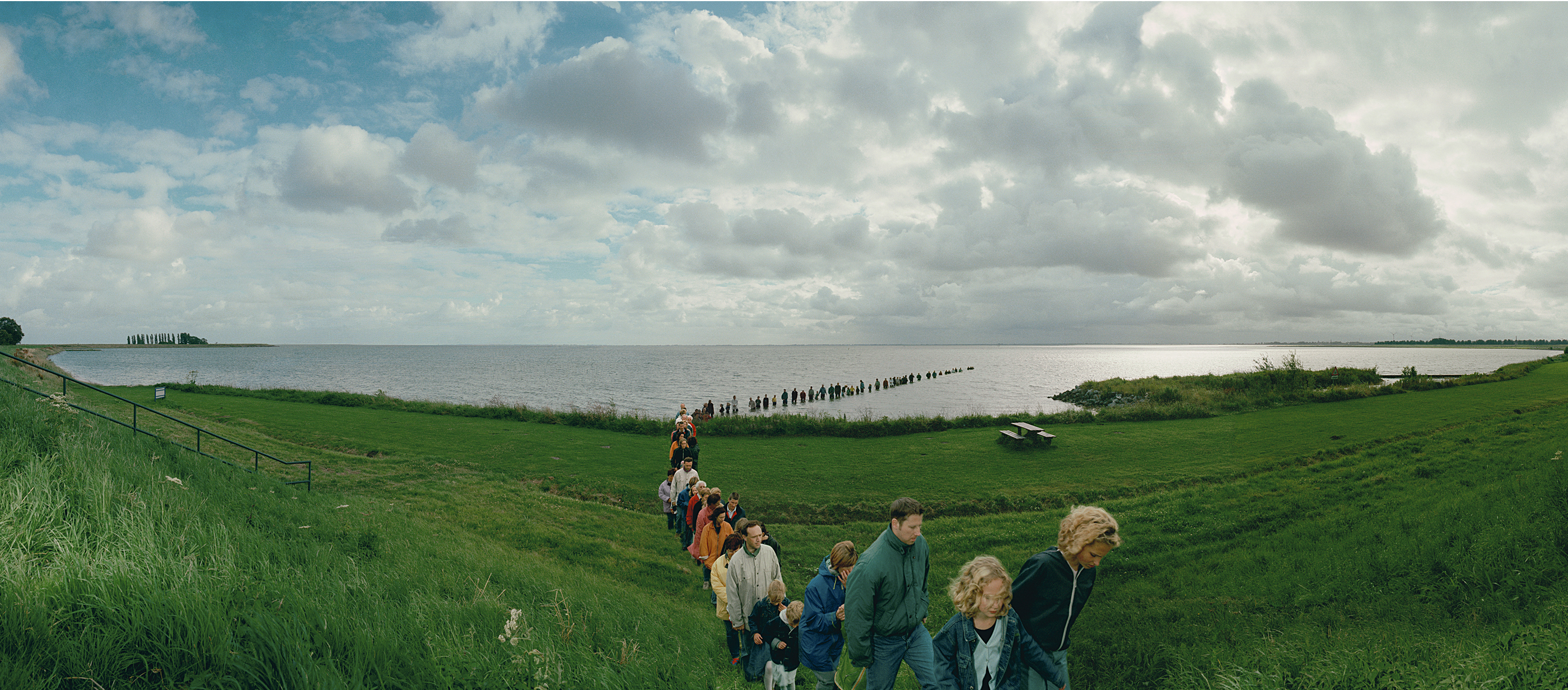
Schellinkhout—de dijk, by Ellen Kooi, 2000. Ilfo Crystal Archive, plexiglass, Reynobond, 30" x 78". © Ellen Kooi, courtesy of the artist and P.P.O.W Gallery, New York.
The prodigy was not quite ready for success. Ill-disciplined and temperamental, he was a “furious boy who won’t stay put,” complained Diderot, who started to distance himself after Loutherbourg was caught in one scandal after another: having sex with Casanova’s wife in the studio and then disgracing his father by eloping with a beautiful widow and later acting as her pimp.
Young Philippe had also begun to amass a formidable library of grimoires—volumes on hermeticism, astrology, and the Kabbala. Rumor had it that his studies were supplemented by practical magic—orgies and rituals—rumors seemingly confirmed when his wife sued him for separation on the grounds that he had squandered her dowry in the pursuit of sex and alchemy, leaving her and their five children drowning in debt. Scandalized, the Académie withdrew its favor just as it was on the verge of inaugurating him into its ranks. In 1768, Philippe left France forever.
In his extracurricular interests, Loutherbourg was no different from a host of educated, fashionable men in the second half of the eighteenth century who participated in an unprecedented occultist resurgence in the decades prior to the French Revolution. “When has Europe been so inundated and overwhelmed with fanaticism,” asked a high-ranking member of the Catholic Church. “Who has not heard…of hobgoblins, sylphs, convulsionaries, magnetists, and cabalists? What is the object of the Freemasons, and those phrenetic societies called the Illuminated, with their plots, their secrets, their invocations, and their ridiculous rites?”
It was a counter-Enlightenment of sorts, one that pushed back against the cultural forces that had shaped the age of reason—the rise of science, empiricism, and the formation of a rational civic sphere. Polite circles across Europe had recoiled from superstitions they saw as plebeian and vulgar; folkloric pursuits such as astrology and divination had been openly derided, their practitioners mocked as relics of a dimly lit past. But reason itself proved inadequate to the task of dislodging longstanding beliefs, however bright its lantern of progress, and it acted instead like a centrifuge that pushed magic into new venues.
In England, the sulfurous rhetoric of John Wesley’s Methodism, for example, drew so heavily on a warring world of invisible spirits that it moved Wesley to declare that “the giving up of witchcraft is, in effect, the giving up of the Bible.” Wesley needed a perpetually warring world of omniscient angels and demons to bring his movement back to the people, and it was a literal fear of ghosts and malignant spirits that drew his followers away from the wheezing sermons of Anglican curates.
The political repression of the ancien régime also played its part by encouraging the growth of secret societies, especially Freemasonry. In 1752 a schism among English Freemasons divided the societies into “ancient” and “modern” lodges under the maladministration of its Grand Master, Lord John Byron, wicked uncle of the famous poet. The ancient lodges advocated a return to “original” rites, along with a commitment to alchemical study and Kabbalistic illumination. Yet their broader agenda was decidedly revolutionary, a Jacobite ideology that opened the brotherhood to tradesmen and merchants, as well as to powerful liberal aristocrats hostile to the suffocating monopolies of their peers.
It was in the visual and literary arts where counter-Enlightenment sympathies found their most natural sanctuary. The work of painters such as Henry Fuseli and Francisco de Goya meditated upon the realms of nightmare and fantasy inherent in imagination, while gothic novelists like Ann Radcliffe, Horace Walpole, and Matthew Lewis imagined communities terrorized by the uncanny, the supernatural, and the perverse. Art was not merely a vehicle for metaphor: aesthetic experience was believed to literally grant access to a superlunary beyond through the powers of imagination and inspiration that echoed, however dimly, the powers of God. For Philippe Jacques de Loutherbourg in particular, art and occultism were fundamentally joined at the level of craft. Unwilling to conceive of his practice as anything other than inherently mystical, he had, since his earliest days as a student in Strasbourg, combined his studies in painting with alchemical research to such an extent that he credited alchemy with leading him to discover a new way of fixing and enhancing pigments that would become the central element of his noted facility with color. The language of color was an important part of alchemical study, and Loutherbourg made himself its master, filling his paintings with its imagery, illuminating his canvases with creative and destructive flames, the subtle arcana of the magic world he felt inhabited his art.
London was a natural destination for Loutherbourg and his kind. It was home to prominent occultists such as the Swedish visionary Emmanuel Swedenborg, whose theosophical teachings inspired the poet William Blake’s conversations with angels; as well as Samuel Falk, the turbaned Jewish alchemist known as the “ba’al shem of London,” who had escaped a sentence to be burned at the stake for necromancy in Westphalia. He held court in a secret alchemical laboratory in a house in the middle of London Bridge, where he instructed pupils such as the Duc d’Orleans in the task of hastening the advent of the Messiah. A handsome man and alluring presence, Loutherbourg moved freely between the worlds of alchemy and fashion, and it was not long before he was introduced to David Garrick, manager of Drury Lane theater and the most celebrated actor of his day. At fifty-five, Garrick was scaling back his performances, but as his onstage roles diminished, his interest in theatrical spectacle grew.
In the late eighteenth century, British stagecraft was in a sorry state, having remained largely unchanged since before the Civil War, when performers stood before lifeless backdrops on stages lit by blazing candelabra. Unlike its French counterpart, which had undergone a neoclassical revival during the days of Jean Racine, Molière, and Pierre Corneille, British theater remained avowedly public and popular, much to the dismay of European visitors alarmed by the volume and influence of the “mop squeezers” and “fart catchers”—maids and footmen—who inhabited the upper galleries, indifferent to their superiors below.
For hundreds of years, the Parisian theater led the way in dramatic splendor. The scenic wonders of its royal masques and court entertainments were something that Garrick could only dream of in his cramped marketplace theater. Seeing how eager Garrick was for innovation, Loutherbourg handed the actor his trump card—a letter of recommendation from the former manager of the Opéra Comique. The painter set about persuading the great man that he was able to produce scenic effects unlike anything ever witnessed in Europe. “I do not want to do for you a commonplace thing such as has already been done in some other places,” he wrote shortly afterward, “but really something which will do me honor and profit you and I…Furthermore,” he continued:
I must make a small model of the settings and everything which is required, to scale, painted and detailed so as to put the working painters and machinists and others on the right track by being able to faithfully copy my models, and if I deem it necessary to retouch something in the final display, to enhance the effect, then I must do so. I shall draw in color the costumes for the actors and the dancers. I must discuss my work with the composer and the ballet master…If you were to give me full authority over all of your workers, I would use this trust as an honest man and would treat your interests as my own.
All he required was the unprecedented salary of five hundred pounds a season, equivalent to Garrick’s own first contract at Drury Lane.
The entire gambit was a bluff, a bit of bluster on behalf of Loutherbourg, who had never worked in a theater in his life. Yet his talent and self-belief were unquestionable, and given that Garrick himself was sympathetic to the esoteric arts, he willingly accepted the Frenchman’s promise that he would soon be “harvesting the celestial manna.”

Aurora australis, viewed from 215 nautical miles above the Pacific Ocean, March 2012. Photograph by an American astronaut, taken from the International Space Station. Courtesy of NASA.
Loutherbourg began work in the autumn of 1772, assuming control of the scenic design and bringing the competing fiefdoms of the Georgian theater—lighting, orchestra, scenery, costume, corps de ballet—under the aegis of his all-seeing eye, inventing the role of creative director. They were innovations that united the company in more ways than one, as Loutherbourg was roundly loathed from the brightest stars to the lowliest understrappers for his high-handedness and pathological addiction to mystery: he refused to commit any of his “secrets” to paper and directed his assistants by means of hushed instructions—referring to them as “attendant genii” christened with “fearful cabalistic” names.
The new creative director of Drury Lane considered himself superior to stage folk, and in his free time consorted mainly with visual artists, especially those who shared his interests, including the sculptor John Flaxman, the painter Thomas Gainsborough, and the portraitist Richard Cosway, a practitioner of “magnetic clairvoyance” who claimed to have telepathic conversations with his wife, and who owned a manuscript on angel magic supposedly written by Peter Paul Rubens. There were scuffles with the other maîtres, including the ballet master Giuseppe Grimaldi, father of the famous clown Joseph, who bore a fearsome reputation of his own. A territorial spat escalated into an impromptu duel when Grimaldi took a swipe at Loutherbourg with his violin bow, and the painter replied with a slash of his brush, leaving Grimaldi with a stripe of paint across his face that “looked as if he had cut his head into two parts.”
As difficult as he was, Loutherbourg delivered. From the battleships of Alfred and beyond, he developed his range of scenic tricks for nine more seasons, during which time he produced effects that were so realistic that “the eye of the spectator might be so effectually deceived…as to be induced to take the produce of art for real nature.” His revolution brought depth and consistency to any scene: raked set pieces created a vanishing point, and cut pieces framed the stage at staggered intervals. He removed the footlights, which had a tendency to cast the actor’s faces in ghoulish chiaroscuro, and instead installed lighting above the proscenium behind slips of colored glass. These could be shifted or combined to produce the effect of sunshine, moonlight, or volcanic glows, even changing the color of foliage from green to red. He cast angled light from multiple sources that revealed different scenes onto transparent back cloths depending on whether they were lit from the front or back. Scenery was properly carpentered in three dimensions, allowing actors to interact with it for the first time, appearing in doorways or at windows, leaping from bridges and scaling castle walls. He designed all the costumes to give the production a sense of its own coherence, and most importantly, he set it all behind the proscenium arch, to give the audience the sense they were watching a moving picture.
There is not so contemptible a plant or animal that does not confound the most enlarged understanding.
—John Locke, 1689As audiences hungrily consumed this world of wonders, Garrick tripled the budget for sets, setting in motion a series of expansions to accommodate ever more lavish scenery until the nature of the theater was irrevocably changed: a largely auditory experience became a predominantly visual one, and five-act dramas made way for hybrid forms that exploited the stage’s new capacity for color and action.
For Loutherbourg, the mechanical was indivisible from the mystical. He was the hermit who revealed prophecies to King Alfred, a mystic who harnessed the technologies of illusion so that they might better embody the magical qualities of transformation, transmutation, and change. In London, Loutherbourg attended Baptist chapels, theosophical meetings, and was initiated into a host of Masonic orders, including the rites of the Illuminés Théosophes, whose “Universal Society,” aimed to “conciliate all doctrines, and even all interests, making constant use of all its talents and directing all its energies to the general well-being of the whole earth.”
Like the Methodist Wesley, Loutherbourg believed in a world infused with God to the very atom, an anima mundi where the laws of physics were Christian mysteries, and physical transformations were akin to spiritual ones. At his core was an enduring interest in revelation—understood literally, figuratively and eschatologically as the removing of a surface to reveal a previously obscured truth, one that brings visions of joy and integration into the divine life.
The purest expressions of these ideas came after Loutherbourg had ceased to work at Drury Lane, one of the many employees to depart after Garrick sold the theater to the charming, larcenous, and financially chaotic playwright Richard Brinsley Sheridan. Sheridan wanted to halve Loutherbourg’s exorbitant salary, so the painter left to build spectacles for small and exclusive audiences who could afford to pay the high entrance fee.
The first of these was staged in an upstairs room of his own luxurious home in Lisle Street, on February 26, 1781. Called Eidophusikon, or Representation of Nature, it was an ingenious entertainment that took place in a box ten feet wide, six feet high, and eight feet deep that was placed at one end of a darkened salon, and in which a series of moving scenes were performed to the accompaniment of a harpsichord. Rightly described as one of the earliest precursors of cinema, the Eidophusikon was Alfred in miniature, using tiny models and mechanized sets to create detailed representations of dawn over Greenwich Park, midday at the port of Tangier, sunset over Naples, the moon rising over the Mediterranean with fires lit ashore, and a shipwreck at sea—each scene with a complete narrative arc full of sound and movement.
From this world inside a box, Loutherbourg’s next project took a five-hundred-acre country estate as its canvas under instruction from William Beckford, a highly affected and unorthodox young man with an interest in Eastern mysticism. Having recently inherited one of the largest fortunes in Britain, Beckford hired Loutherbourg to decorate his Christmas party, for which the artist promised “something that eye has not yet seen or heart of man conceived.” The house was lit to look like a “warm, illuminated palace raised by spells in some lonely wilderness,” while inside, Loutherbourg had constructed a fully immersive alternative reality.
For three days, Beckford and his guests wandered though an enchanted dominion, richly carpeted rooms full of art and treasures, skillfully transformed into a “necromantic region,” or what Beckford called “one of those temples deep below the earth set apart for tremendous mysteries.” Incense rose from japanned bowls, tables swung out from behind curtains laden with fresh flowers and “delicious consommations,” only to disappear without a trace. Music issued from invisible performers—sometimes an organ, sometimes an orchestra, Gregorian chant, or a sweet cantata sung by one of Beckford’s three favorite castrati. The centerpiece was a vast Egyptian hall bathed in a larval glow, dressed to look as if it had been hewn out of solid rock. Shut in on this morphetic world with no natural light permitted to enter, the guests soon lost all sense of time and place. “The glowing haze, the mystic look, the endless intricacy of the vaulted labyrinth produced an effect so bewildering that it became impossible for anyone to define exactly where at the moment he was wandering.”
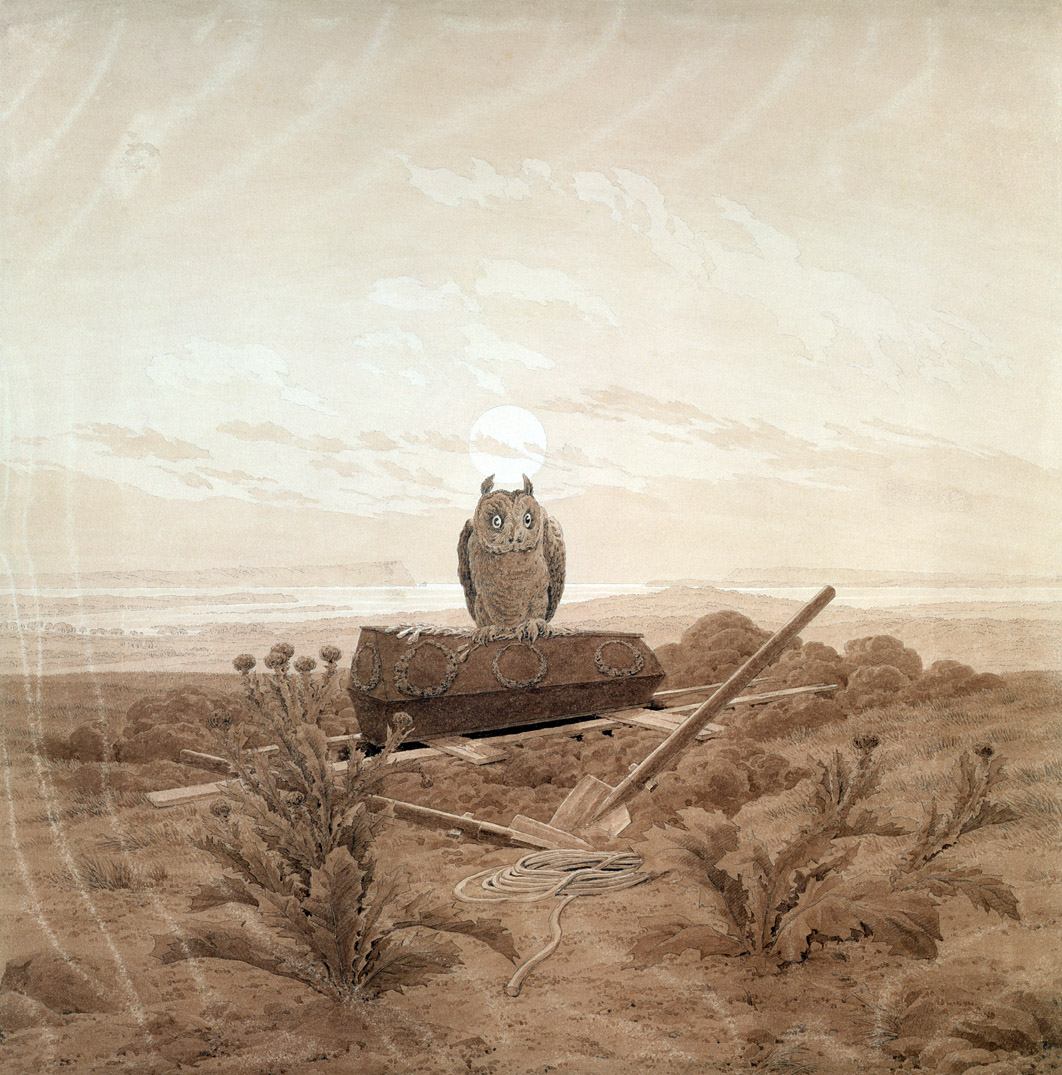
Landscape with Grave, Coffin, and Owl, by Caspar David Friedrich, c. 1836. Hamburger Kunsthalle, Hamburg, Germany.
Ultimately for Loutherbourg, both Beckford’s party and the Eidophusikon proved to be financial dead ends, neither providing a sustainable source of income nor leading the way to newer innovations. He returned to the stage for one more spectacle—Omai, or, A Trip Around the World, a play based on Captain Cook’s discoveries in the South Seas—before a mysterious stranger brought his theatrical career to quick end.
In 1786, a powerful occult figure appeared in London after his release from the Bastille. Known as Count Alessandro Cagliostro, a pot-bellied evangelist and clairvoyant, he was the “Great Copt” of Egyptian Rite Freemasonry claiming to have disciples in the “many millions.” The Egyptian Rite was unique among Masonic orders in that it admitted both women and Jews in its quest to return Masonry to its core unifying purpose, the recovery of the patriarchal religion that had allowed Adam, Noah, and Abraham to speak directly to God. To do this, Cagliostro offered to lead his initiates through a process of moral and physical rejuvenation attained through rigorous prayer and health regimes.
He demanded his followers retire to the country for the entire month of May, eat laxative herbs, drink rain, and follow an enervating program of phlebotomy to prepare the body to receive three grains of panacea that caused them to lose the power of speech and experience three days of convulsions. When, on the thirty-sixth day, the initiate ate his final grain of panacea and fell into a deep, tranquil sleep, his hair, skin, and teeth were supposed to shed and regrow in a matter of hours. Total rejuvenation was attained on the fortieth day, when the initiate awoke to find his body made entirely of new matter with the capacity to live for 5,557 years. For those without the discipline to undergo such an arduous rebirth, Cagliostro offered seances and rituals in which child mediums conversed with angels to foretell the future.
Naturally, it was a scam. Cagliostro was a charlatan, forger, con man, and possible murderer, who had begun his career in Palermo as a painter named Joseph Balsamo. Nevertheless, he was feted on his arrival in London, and both the king’s brother, the duke of Cumberland, grand master of the English Masons, and his nephew, the prince of Wales, a future grand master, were among those who paid their respects.
Loutherbourg, too, was an ardent follower, inviting Cagliostro to share his house on the Thames in Hammersmith. The con man agreed, seeing immediately how the artist could be of use to him. Cagliostro’s rites were extremely theatrical; his ceremonies used smoke and billowing linen, phantasmagoric images, and crystal vases eerily lit by tapers in which his child mediums saw visions of paradise and events in far-off places. To communicate with the highest angels, the medium entered a specially constructed tabernacle like a magician’s cabinet, where he would seek the counsel of the seven archangels of the apocalypse, who acted as a kind of social committee with the final say on who was allowed in.
The fear of the Lord is true wisdom, and he who hath it not can in no way penetrate the true secrets of magic.
—Abraham the Jew, 1400Cagliostro hoped to entirely perfect the sensory aspect of his rituals and commissioned Loutherbourg to paint a series of occult pictures to decorate his newly founded London lodge. Yet the count’s dream of conquering British Masonry ran into trouble, thanks to the many enemies he had accrued in the course of a long magical life, outraged citizens and disenchanted devotees who had pursued him through Europe seeking to discredit his rituals and unmask him as a swindler and a fraud.
The most zealous of these was the editor of the Courier de l’Europe, a gutter journalist and spy in the pay of France’s naval high command named Charles Thevenot de Morande. From his office in London, Morande marshaled his formidable European contacts to smear Cagliostro in the pages of his paper, even going so far as to import his creditors from abroad in an attempt to have the magician arrested for debt. By April 1787 his threats had gained sufficient traction for Cagliostro to go into hiding, and then decide to leave England entirely and seek refuge among friends in the Swiss town of Bienne.
Loutherbourg traveled with him, but in such close quarters, their alliance soon faltered. They argued over money, status, and women. A struggle for supremacy took place in the drawing rooms of Bienne, each man trying to discredit the other, until finally violence spilled over into the spirit world when one of Cagliostro’s child mediums reported a vision of Loutherbourg revealing a wounded heart and flourishing his sword.
Convinced he was the more powerful man, Loutherbourg left Switzerland and returned to London, where he began a offering his services as a faith healer with such success that on “healing days,” his house was besieged by up to three thousand pitiful souls. A rudimentary triage was established to impose some kind of order, and tickets were handed out, but this only gave rise to a black market, as gangs of ruffians extorted them from the sick and sold them for five guineas apiece. Disorder was inevitable, and Loutherbourg was forced to discontinue his service after his house was damaged in the course of a riot. In 1789 he returned to his easel, painting a series of landscapes and naval scenes that brought him both profit and renown during the wars with France, but his retirement from the world of transformation was complete.
His influence, however, had made its indelible mark. In 1791, Garrick’s successor tore down the dilapidated Drury Lane and had it completely rebuilt to house the kind of spectacles Philippe had been the first to imagine. Three years later it reopened as the largest theater in Europe and one of the tallest structures in London, seating up to four thousand people. “You have come to act in a wilderness of a place,” complained a hoarse Sarah Siddons to a new recruit. The first hit of the new season was a burletta in which a full-scale castle was consumed by real flames, armies of Poles and Tartars fighting on its collapsing battlements to a thunderous orchestral accompaniment, and barely a word passing between them. The stage was already becoming a screen, hastening toward our era of industrial entertainment where the only limits to projecting our fantasies are the boundaries of technology. But while Loutherbourg had anticipated this move in the direction of ever-refined illusion, his aim had never been to fabricate reality down to the last granule. Verisimilitude was his occult science, a way of showing that what we see is the thinnest of veils.
